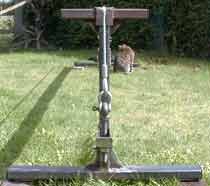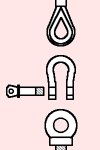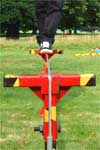|
Navigation









External links



Documents


|
|
Tight ropes and other big toys.
|
|
Wires and ropes - the differences.
|
|
 The tight rope - or more properly tight wire - consists of a high-tensile steel wire slung between two anchorage points, and kept under very high tension. Because of the forces involved, tight wires need to be very heavy duty in their construction. If the wire is not maintained at a high enough tension, then the wire will increasingly take on the characteristics of a slack rope (see below).
The tight rope - or more properly tight wire - consists of a high-tensile steel wire slung between two anchorage points, and kept under very high tension. Because of the forces involved, tight wires need to be very heavy duty in their construction. If the wire is not maintained at a high enough tension, then the wire will increasingly take on the characteristics of a slack rope (see below).
Slack ropes, on the other hand, require much less heavy engineering. A slack rope normally consists of a rope of hemp, jute, or nylon slung between two anchorages set some way off the ground, with the rope hanging loosely between them. When in use, the rope becomes quite taut under the weight of the rope walker, but the forces endured by the anchorages are a fraction of those one might find in a tight rope of similar size.
Tight wires and slack ropes have many techniques in common, and differ quite markedly in other respects. In particular, anybody who has ever tried a slack rope will probably be familiar with 'the wobbles', an easily curable but distinctly unnerving condition!
Nearly everybody finds both wires and ropes very challenging when first attempted, but in truth they are probably more intimidating than genuinely difficult. Where wires and ropes really score, is in their capacity to teach users about balance, poise, and body shape. Indeed, dancers, acrobats, and other physical performers can benefit greatly from walking on ropes and wires, because of the way that good technique encourages poise and body awareness.
|

Walking wire assembly - detail from technical drawings.
|
|
|
Have you got a tight wire and a slack rope, then?
|
|
Jay designed and built his own tight wire rig in the summer of 1999, in an effort to expand the range of larger props available to the company. It is fully portable (as far as anything that weighs 75kg can be described as 'portable'), and was designed to fit easily in the back of Jay's battered Sierra estate. Mercifully, the Sierra has gone the way of all flesh, whereas the tight wire lives on.
Although we haven't quite got around to it yet, we do intend to build a slack rope rig in the not too distant future. In the meantime, two trees and a bit of old rope will have to suffice - don't try this at home kids!
|
|
About Jay's tight wire.
|
|
Jay's tight wire rig is fully transportable, and is completely free-standing when erected. With a maximum dimension of around 7 feet when disassembled, it will fit in the back of most cars and vans, as well as providing a longer walking length than many of the other free-standing portable designs available at the time of writing. The design is also (theoretically) scaleable - if you've got some spare cash knocking around, and you'd like a really huge tightwire, then give me a ring.
It takes around half an hour to erect from scratch to first use, and about fifteen minutes to disassemble and pack away again.
Specifications for the tight wire are as follows :-
|
- Walking length : 4,000mm.
- Overall length : approx. 4,300mm.
- Height : 700mm.
- Width : 800mm.
- Maximum dismantled dimension : 2,270mm.
- Walking wire height : 700mm.
- Assembled weight : 75kg including all tools, accessories, etc.
- Walking wire diameter : 10mm.
- Walking wire SWL : 5,500kg.
- Walking wire nominal breaking strain : 27,500kg - yes, 27 tonnes!
- Counter straining wire diameter : 5mm.
- Counter straining wire SWL : >600kg.
- Counter straining wire nominal breaking strain : 3,000kg.
|
|
|
What's it for, this tight wire?
|
|
Originally conceived as a 'centrepiece' prop for circus skills workshops, the tight wire has proved immensely popular wherever it has been taken, which is all the more surprising given the fiendish difficulty of successfully walking the wire with control (any palooka can leg it across a wire, but can they stand still or turn around. I think not!
At the time of writing, Jay can walk the wire, stop, turn round, juggle, and sit on a chair. He has yet to meet anybody with natural or 'instant' talent for wire walking, but we think it can be learned in an afternoon, given adequate one-to-one time.
|
|
More about tight wires.
|
|
Some words of infinite wisdom from our beloved founder -
Since I first put up this web page some time ago, I have received a slow but steady trickle of enquiries about tight wires in general, from people from all over the world. It's not that I am some sort of expert, or renowned fount of information about tight wires, rather I have been an instrument of Google's page ranking system : If you make a page about something obscure enough, they will come.
Consequently, I have become a little bit of a clearing house for people wishing to ask questions about tight wires. Whilst I enjoy and appreciate the attention, I have to hold my hands up and tell you that I am not the be all and end all when it comes to knowledge of wires. Caveat emptor.
I have, however, assembled a few pages of designs, assembly instructions, and a small gallery of photographs, for public perusal. The designs represent the tight wire which is sitting in my garage as I type, so I suppose that I can say with some confidence that my design works, since it hasn't yet found it's way to the great scrapyard in the sky. You can find those pages here, though you might find them a little rough and ready, since they were prepared in a bit of a hurry. Needs must.
Should you decide to have a go at building a rig for yourself, please mail me and tell me about your experiences. I have sent copies of my design to various different people over the years, and I have yet to see one of my wires materialise. My tight wire is lonely!
- Jay Linn, September 2003.
|
|
|
 Heavy duty
Heavy duty

